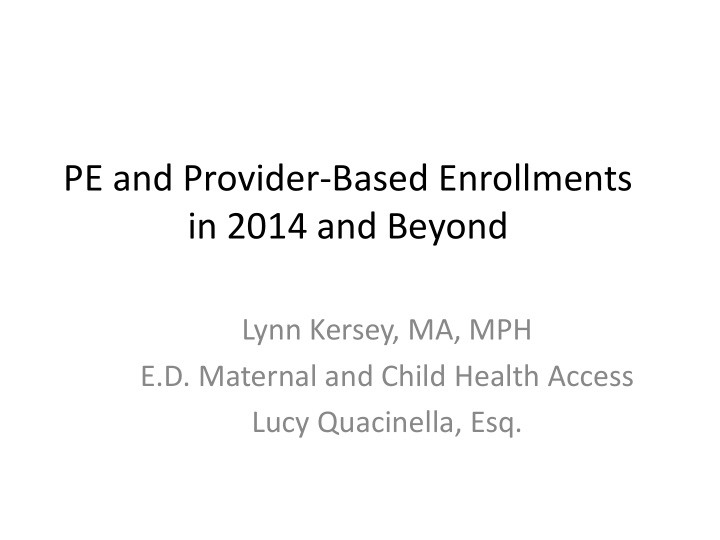



PE and Provider-Based Enrollments in 2014 and Beyond Lynn Kersey, MA, MPH E.D. Maternal and Child Health Access Lucy Quacinella, Esq.
Used at present in Medi-Cal and/or Healthy Families: • Children when a “well - child” exam is due or has been missed (CHDP Gateway) • Pregnant women (PE for Pregnant Women) • Individuals with breast or cervical cancer (BCCTP) • Individuals needing family planning and related services (Family PACT) • Certain disabling conditions • Other? • Cf. PE and state and county enrollments – Accelerated Enrollment (AE) at the SPE – Bridging or “transitioning” between children’s Medi-Cal and Healthy Families – Other? • No community-based PE at present? Why not?
Enduring rationale in 2014: a necessary back stop – Uninsured patients likely to continue to exist – Providers will need a payment source – “In reach” and unique window of opportunity for enrollment – Cost-effective to provide needed care on a timely basis, especially preventive care and treatment for communicable diseases – What will the full CalHEERS application form and documentation process entail? Will providers have the capacity to complete it? • Even if yes, lagging databases in federal and state hubs may mean real time eligibility denials for eligible person – Tax data a year or more old. Wage data a quarter or more old . Cf. “point in time” income eligibillity. – Racial disparities in health care generally and in maternal and newborn deaths and in increases in the rate of HIV infection among African American and Latina women
Prenatal Gateway: Practice for provider-based enrollments in 2014? Medi- Cal’s PE Program for Pregnant Women • Excels at immediate access and coverage through a very simple screening process, with high degree of state monitoring and control. • But coverage ends in a maximum of 62 days without follow up application. – Women who need either on-going or retroactive coverage may have difficulty submitting the follow up application before PE ends. • Extensions of PE are administratively burdensome • Can be difficult to access PE services with paper card
Scope of Coverage Issues • PE does not cover all “ambulatory prenatal care” covered by Medi- Cal’s 200% FPL Program for Pregnant Women. – All such services covered under the 200% program should be in PE – Only in-patient hospital services (e.g., for labor and delivery) may be excluded from PE for pregnant women under federal law. • The 200% Program does not cover all pregnancy-related care. – Default federal definition of “ pregnancy- related” care for FPL programs for pregnant women is “medical necessary” care. Medi- Cal’s 200% program must conform. – For lesser scope, states must now submit a State Plan Amendment, identifying omitted services, explaining why they are “not pregnancy - related,” and obtain the Secretary’s approval. – Most women are able to get the medical care they need under the current scopes of the PE and 200% programs . But for those who cannot, conforming to the federal rule is critical. • Some women would no longer need to apply for on-going or retroactive coverage if the scope of PE coverage conformed to the above.
Promising policy developments • 2008: SB 24 Prenatal Gateway stakeholders recommendations to use simple follow up application adopted by DHCS • 2012: DHCS facilitates use of existing simple follow up application for pregnant women (MC 263 PREMED-2) by authorizing PE providers to fax the completed form to fax numbers dedicated to this purpose in each of the 58 counties.
Even better if. . . • Providers were instructed to mark the PE “good thru” date as “until a final eligibility determination is made”, instead of extensions in 60-day increments • The PE information sheets given to women and the program flowcharts for providers were updated • An All County Letter were prepared, in consultation with the counties, providers and consumer advocates, to ensure that the process on the “back end” operates as smoothly as possible • The MC 263 PREMED-2 form, already extremely simple, were simplified even further. – E.g., “other health coverage” no longer needed given DHCS data-matching
Policy improvements in 1931(b) To simplify Medi-Cal, ease administrative burdens at the county and the time it legitimately takes to process an application, promote early access to pregnancy-related care, and prepare for ACA implementation in 2014: • Drop the “third trimester” rule • Drop the “deprivation” rule for pregnant women – Now nearly synonymous with income below poverty – Will become even more irrelevant in 2014 with the adult expansion category. • Drop the 1931(b) assets test for pregnant women now – Will be eliminated in 2014 in both the 1931(b) and new expansion programs
Adopt an electronic version of the Prenatal Gateway per CalHEERS RFP • Digitized version of the MC 263 PREMED-2 should be made available to PE providers for on-line submission • Could also serve as a “trial run” for CHDP Gateway improvements • The elements of eligibility for the two groups- children and pregnant women — are nearly identical as are some of the challenges both groups face under the current structure for PE. • Follow up application must be optional for consumers • The “trial run” would also provide insight into possible approaches in 2014 for the new adult PE category and hospital services PE.
Thank you Questions? Comments? lynnk@mchacces.org lucy@quacinella.com
Recommend
More recommend